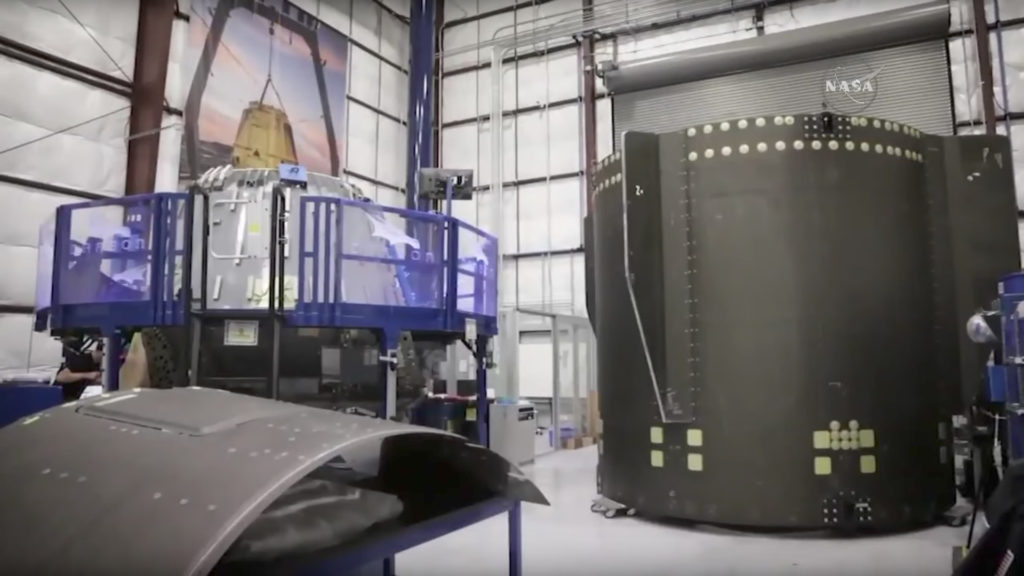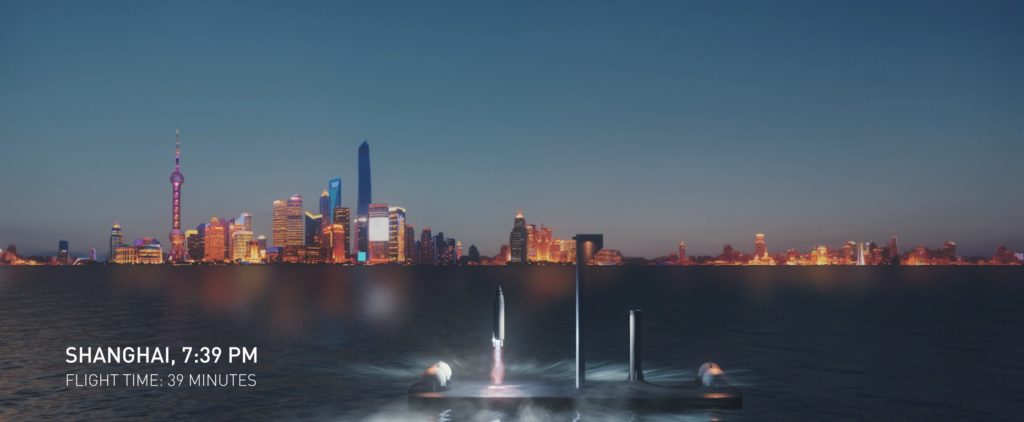

News
SpaceX urges White House to foster public-private partnerships in space
Earlier this year, the White House announced plans to reestablish the National Space Council (NSC), an advising body that dates back to the creation of NASA in 1958. The council convened for the first time on October 5 and invited several central figures in US spaceflight, including SpaceX’s President and COO Gwynne Shotwell.
In a brief but powerful speech to the Council, Shotwell urged the US Federal government to apply the lessons learned from NASA’s successful private-public partnerships to efforts to expand human presence in Low Earth Orbit and beyond. Those successful partnerships include NASA COTS (Commercial Orbital Transportation Services), which funded SpaceX to develop its Cargo Dragon spacecraft to resupply the ISS, and the Commercial Crew Program (CCP) that funded SpaceX for the development of their crewed Dragon 2 spacecraft. In terms of efficiency and speed, both programs have indeed been extraordinarily successful, despite often maligned delays.
As a brief example of the insignificance of SpaceX’s Commercial Crew delays, one needs to look no further than NASA’s Space Launch System. Described in early 2011 to be pursuing operational readiness no later than December 2016, SLS is now extremely unlikely to conduct its first launch until well into 2020. A reasonable cost estimate spreads the development costs ($30 billion) over 30 years of operations, assumes an optimistic one launch per year for the vehicle, and arrives at an astounding final figure of $5 billion per SLS launch.
The development funds NASA awarded SpaceX for both Cargo Dragon, Falcon 9, and Crew Dragon were estimated to be no more than $7.3 billion from 2006 to the last Cargo Dragon mission currently scheduled for 2024. Even if this figure swells to $10 billion once operational crewed flights to the ISS begin in 2018 or 2019, the entire cost of NASA’s support of SpaceX would equate to two launches of SLS total.

NASA slipped a sly glimpse of Dragon 2 construction into their live coverage SpaceX’s CRS-12 launch. On the left is a Dragon 2 pressure vessel, while on the right is the vehicle’s “trunk”. (NASA)
Shotwell made sure to avoid the topic of SLS entirely, instead choosing to highlight the benefits of cost and speed public-private partnerships could provide for deep space communications and interplanetary cargo transport. This marks the second time that a ranking member of SpaceX has mentioned a possible public-private program for deep space communications, something that will inevitably need to improve as the commercial spaceflight apparatus extends its reach beyond Earth. SpaceX is currently developing satellite technology to enable a massive orbital Internet constellation around Earth, and the company is obviously interested in leveraging that R&D to strengthen Earth-Mars and Earth-Moon networks into a more robust communications backbone. Secretary of Transport Elaine Chao and Secretary of State Rex Tillerson also slipped in words of excitement and interest in SpaceX’s recently revealed concept of point to point Earth transportation with their BFR system.
This meeting of the NSC also focused heavily on the domestic and regulatory apparatus for commercial space operations. Shotwell and Blue Origin’s CEO Bob Smith both suggested that the FAA’s current rules and regulations regarding commercial spaceflight ought to be reviewed and potentially updated to better account for a future of reusable commercial launch vehicles. Shotwell subtly maligned the often-tedious process of applying for FAA launch permits, pointing to the fact that even slight changes to permits would force companies to file entirely new applications, often taking six months or longer. SpaceX, with its rapid development and deployment of reusable rockets and an ever-increasing launch cadence, is more than ever before at odds with the FAA’s slow and unforgiving permitting processes.

SpaceX’s BFR Earth transport concept would undoubtedly clash head-on with the FAA’s current system of rocket regulations. (SpaceX)
Intriguingly, Council members Mike Pence, Mick Mulvaney, and Elaine Chao all expressed a desire to ease the burden of anachronistic regulations on the commercial space industry. More interesting still, the commercial space panel ended with what effectively sounded like a handshake deal between the Vice President, the Secretary of Transportation, and the Director of the Office of Management and Budget to review current commercial spaceflight regulations and report the results of those reviews to the NSC in no more than 45 days.
It remains to be seen if this verbal commitment translates into an official review, but it is at a minimum encouraging to hear ranking members of the current White House administration so openly express support for SpaceX, Blue Origin, Sierra Nevada Corp., and American commercial spaceflight in general.
The First Meeting of the National Space Council can be seen in the embed below.
https://www.youtube.com/watch?v=nh2jVG76S7g

News
Tesla FSD fleet is nearing 7 billion total miles, including 2.5 billion city miles
As can be seen on Tesla’s official FSD webpage, vehicles equipped with the system have now navigated over 6.99 billion miles.

Tesla’s Full Self-Driving (Supervised) fleet is closing in on almost 7 billion total miles driven, as per data posted by the company on its official FSD webpage.
These figures hint at the massive scale of data fueling Tesla’s rapid FSD improvements, which have been quite notable as of late.
FSD mileage milestones
As can be seen on Tesla’s official FSD webpage, vehicles equipped with the system have now navigated over 6.99 billion miles. Tesla owner and avid FSD tester Whole Mars Catalog also shared a screenshot indicating that from the nearly 7 billion miles traveled by the FSD fleet, more than 2.5 billion miles were driven inside cities.
City miles are particularly valuable for complex urban scenarios like unprotected turns, pedestrian interactions, and traffic lights. This is also the difference-maker for FSD, as only complex solutions, such as Waymo’s self-driving taxis, operate similarly on inner-city streets. And even then, incidents such as the San Francisco blackouts have proven challenging for sensor-rich vehicles like Waymos.
Tesla’s data edge
Tesla has a number of advantages in the autonomous vehicle sector, one of which is the size of its fleet and the number of vehicles training FSD on real-world roads. Tesla’s nearly 7 billion FSD miles then allow the company to roll out updates that make its vehicles behave like they are being driven by experienced drivers, even if they are operating on their own.
So notable are Tesla’s improvements to FSD that NVIDIA Director of Robotics Jim Fan, after experiencing FSD v14, noted that the system is the first AI that passes what he described as a “Physical Turing Test.”
“Despite knowing exactly how robot learning works, I still find it magical watching the steering wheel turn by itself. First it feels surreal, next it becomes routine. Then, like the smartphone, taking it away actively hurts. This is how humanity gets rewired and glued to god-like technologies,” Fan wrote in a post on X.
News
Tesla starts showing how FSD will change lives in Europe
Local officials tested the system on narrow country roads and were impressed by FSD’s smooth, human-like driving, with some calling the service a game-changer for everyday life in areas that are far from urban centers.

Tesla has launched Europe’s first public shuttle service using Full Self-Driving (Supervised) in the rural Eifelkreis Bitburg-Prüm region of Germany, demonstrating how the technology can restore independence and mobility for people who struggle with limited transport options.
Local officials tested the system on narrow country roads and were impressed by FSD’s smooth, human-like driving, with some calling the service a game-changer for everyday life in areas that are far from urban centers.
Officials see real impact on rural residents
Arzfeld Mayor Johannes Kuhl and District Administrator Andreas Kruppert personally tested the Tesla shuttle service. This allowed them to see just how well FSD navigated winding lanes and rural roads confidently. Kruppert said, “Autonomous driving sounds like science fiction to many, but we simply see here that it works totally well in rural regions too.” Kuhl, for his part, also noted that FSD “feels like a very experienced driver.”
The pilot complements the area’s “Citizen Bus” program, which provides on-demand rides for elderly residents who can no longer drive themselves. Tesla Europe shared a video of a demonstration of the service, highlighting how FSD gives people their freedom back, even in places where public transport is not as prevalent.
What the Ministry for Economic Affairs and Transport says
Rhineland-Palatinate’s Minister Daniela Schmitt supported the project, praising the collaboration that made this “first of its kind in Europe” possible. As per the ministry, the rural rollout for the service shows FSD’s potential beyond major cities, and it delivers tangible benefits like grocery runs, doctor visits, and social connections for isolated residents.
“Reliable and flexible mobility is especially vital in rural areas. With the launch of a shuttle service using self-driving vehicles (FSD supervised) by Tesla in the Eifelkreis Bitburg-Prüm, an innovative pilot project is now getting underway that complements local community bus services. It is the first project of its kind in Europe.
“The result is a real gain for rural mobility: greater accessibility, more flexibility and tangible benefits for everyday life. A strong signal for innovation, cooperation and future-oriented mobility beyond urban centers,” the ministry wrote in a LinkedIn post.
News
Tesla China quietly posts Robotaxi-related job listing
Tesla China is currently seeking a Low Voltage Electrical Engineer to work on circuit board design for the company’s autonomous vehicles.

Tesla has posted a new job listing in Shanghai explicitly tied to its Robotaxi program, fueling speculation that the company is preparing to launch its dedicated autonomous ride-hailing service in China.
As noted in the listing, Tesla China is currently seeking a Low Voltage Electrical Engineer to work on circuit board design for the company’s autonomous vehicles.
Robotaxi-specific role
The listing, which was shared on social media platform X by industry watcher @tslaming, suggested that Tesla China is looking to fill the role urgently. The job listing itself specifically mentions that the person hired for the role will be working on the Low Voltage Hardware team, which would design the circuit boards that would serve as the nervous system of the Robotaxi.
Key tasks for the role, as indicated in the job listing, include collaboration with PCB layout, firmware, mechanical, program management, and validation teams, among other responsibilities. The role is based in Shanghai.
China Robotaxi launch
China represents a massive potential market for robotaxis, with its dense urban centers and supportive policies in select cities. Tesla has limited permission to roll out FSD in the country, though despite this, its vehicles have been hailed as among the best in the market when it comes to autonomous features. So far, at least, it appears that China supports Tesla’s FSD and Robotaxi rollout.
This was hinted at in November, when Tesla brought the Cybercab to the 8th China International Import Expo (CIIE) in Shanghai, marking the first time that the autonomous two-seater was brought to the Asia-Pacific region. The vehicle, despite not having a release date in China, received a significant amount of interest among the event’s attendees.








